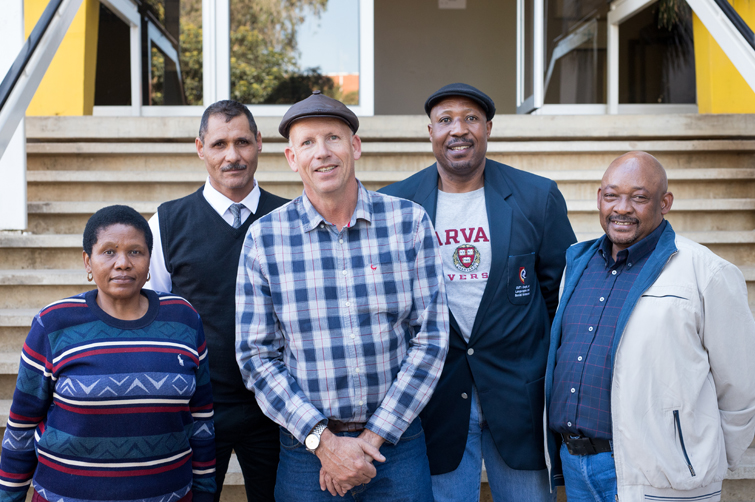Latest News Archive
Please select Category, Year, and then Month to display items
13 January 2020
|
Story Eugene Seegers
|
Photo Anja Aucamp
 Spearheading the digital expansion of the conversational Sesotho course is IDEAS Lab Director, Johann Möller (middle). With him are from the left: Prof Pule Phindane, CUT; Dr Brenton Fredericks, CUT; Bahedile Letlala, UFS Department of African Languages; and Dr Elias Malete, UFS Department of African Languages.
Spearheading the digital expansion of the conversational Sesotho course is IDEAS Lab Director, Johann Möller (middle). With him are from the left: Prof Pule Phindane, CUT; Dr Brenton Fredericks, CUT; Bahedile Letlala, UFS Department of African Languages; and Dr Elias Malete, UFS Department of African Languages.
For many years now, the UFS has been offering a one-year course in conversational Sesotho for staff members; this can then be followed up with the one-year course in advanced conversational Sesotho. The conversational Sesotho for students in the Faculty of Education was introduced in 2018 at the UFS.
The Central University of Technology (CUT) needed a conversational course for its first-year students and approached the Department of African Languages for the development of such a course. Living as we do in a multilingual country; this additional language skill opens doors and often hearts as well.
Using instructional design principles
However, the need was identified by both CUT and UFS to present this crucial information in a way that would be more appealing to digital natives as well as to those less familiar with technology. The Department of African Languages on the UFS Bloemfontein Campus, together with relevant departments from the CUT, approached the IDEAS Lab located on the UFS South Campus, since they already have a reputation for being a specialist on broadcasting and repackaging curricular content for digital presentations. The IDEAS Lab provided technical advice and built the multimedia programme, which will help the user to hear and practice phrases in Sesotho, using instructional design principles. The course will be available to both staff and students belonging to the two universities.
Room for growth
Johann Möller, Director of the IDEAS Lab, says this pilot programme will give both institutions the opportunity to test the use of multimedia for language acquisition. He adds, “Language is extremely complex, and we would like to expand this learning aid in the future.” In fact, the original design has room for growth built into it.
To keep things simple for the user and the building team, it was decided to start out with only four potential everyday scenarios where a staff member would like to speak Sesotho: Firstly, how to greet other persons from different genders; secondly, potential scenarios one might encounter in the university environment itself; thirdly, how to deal with situations at a hospital; and finally, how to use one’s language skills at a filling station.
Pronunciation is key
Each scenario contains three to four conversations that the learner can revise, along with images and audio that illustrate the situation and assist with correct pronunciation. The system does not allow the user to progress unless they have listened to the pronunciations of the sample sentences or phrases.
Further reading material and vocabulary lists are also provided, with the result that people who are using the programme can learn at their own pace. The authoring software Articulate Storyline was used to build the individual scenarios and each conversation or lesson within it. The lessons are also not dependent on an internet connection; they can be downloaded onto a flash memory drive and used offline.
Final lecture in Darwin series presented at the UFS
2010-02-23
 |
At the lecture were, from the left: Prof. Terence McCarthy, Prof. Jo van As, Chairperson of the Darwin 200 Committee and Head of the Department of Zoology and Entomology at the UFS, Prof. Bruce Rubidge, Elsabe Brits, journalist at Die Burger and Esther van der Westhuizen, presenter on Groen.
Photo: Leonie Bolleurs |
The University of the Free State (UFS), in collaboration with the Central University of Technology, Free State (CUT) and The National Museum in Bloemfontein recently hosted the final lecture on the Charles Darwin lecture series entitled “The story of life and survival”.
The lecture was presented by Prof. Bruce Rubidge, the Director of the Bernard Price Institute for Paleontological Research at Wits University and Prof. Terence McCarthy, a Professor of Mineral Geochemistry at Wits and Head of the Department of Geology. Proff. Rubidge and McCarthy are co-authors of the book The Story of Life on Earth.
Their lecture with the topic “Trends in evolution and their bearing on the future of humankind” dealt with the future of evolution. According to Prof. Rubidge, ninety-nine percent of the species that have ever lived are extinct. “We are living in a time of mass extinction. Fifty thousand species become extinct annually,” he said.
Prof. McCarthy discussed many factors that can result in mankind’s extinction today. The impact of climate change, big volcanic eruptions, a comet or asteroid hitting earth, tsunamis and the collapsing of sea islands are some of the factors Prof. McCarthy believes could cause great catastrophe’s on earth.
“We live on the brink of this all the time,” he said.
Prof. McCarthy also believes that we can avoid these catastrophes. By allowing only one child per family we can shrink the global population with 30% per generation. This is doable in a short time span,” he said.
Other ideas he had on saving mankind from getting extinct is to create extensive ecological reserves on land but especially in the ocean, to decentralise everything, to change to renewable energy, to recycle resources and to be vigilant in doing this.